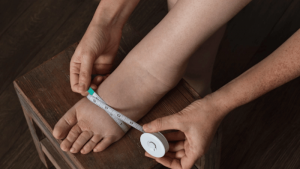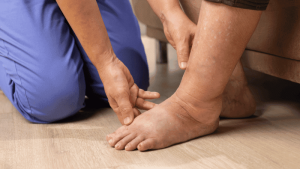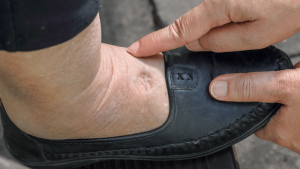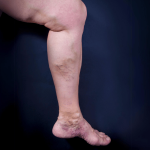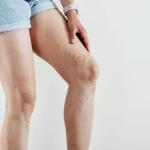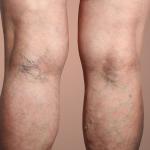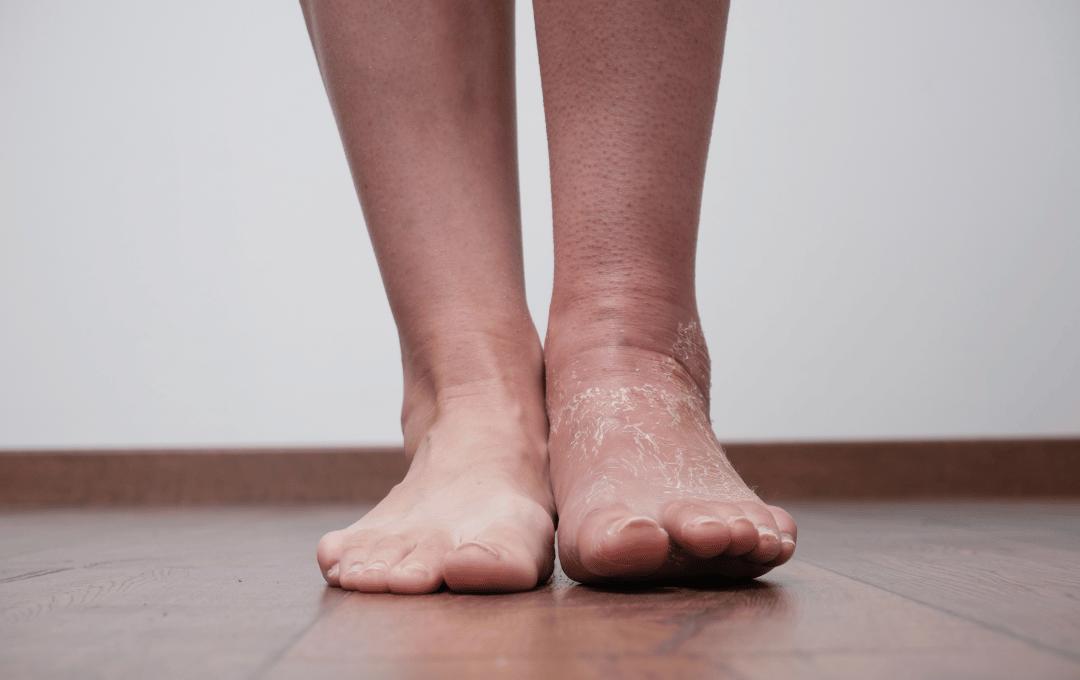
Table of Contents
Most people don’t expect to wake up and find one leg suddenly more swollen than the other. Yet, as a vein specialist, this is one of the most frequent concerns I hear from patients. Some notice the swelling slowly, over weeks or months. Others feel a tightness around the ankle or calf that wasn’t there the day before. Naturally, their first question is:
“Is this something serious?”
Swelling in a single leg known medically as unilateral swelling, is your body’s way of saying something isn’t functioning as it should in the veins, lymphatic system, or surrounding tissues. While some causes are mild, others require urgent attention. Understanding those differences is key.
Worried About Swelling in One Leg? A vein specialist can help you understand what’s causing your symptoms and recommend the right treatment.
Schedule a Swelling Leg Consultation
When Should You Be Concerned About One-Leg Swelling?
Swelling that affects both legs often relates to general fluid retention. But swelling in just one leg usually points to a local issue, something affecting the leg’s circulation or lymphatic drainage.
Seek medical evaluation if the swelling:
- Sudden swelling in one leg
- Swelling with redness, warmth, or throbbing
- Tightness or heaviness that worsens as the day progresses
- Skin discoloration, which may relate to venous skin changes
- Pain in the calf (a potential early DVT sign)
- Swelling after prolonged sitting or travel — a risk factor also tied to sedentary lifestyle effects on vein health
These clues help us distinguish between everyday causes and conditions that require urgent evaluation.
What Causes Swelling in One Leg Only?
Below are the most common causes I diagnose in clinical practice. Understanding how they behave can help you narrow down what’s happening in your own body.
Chronic Venous Insufficiency (CVI)
CVI is one of the most frequent causes of leg swelling. In this condition, the valves inside your veins which normally keep blood moving upward toward the heart become weak or damaged. When they fail, blood flows backward and pools in the lower leg. This pooling increases pressure, leading to swelling, aching, and skin changes.
Common symptoms include:
- Heaviness or fullness in the leg
- Swelling that worsens as the day progresses
- Varicose veins
- Skin discoloration or thickening
- Itching or burning sensation
- Restless legs or cramps at night
- Venous ulcers
CVI often affects one leg more than the other, especially if there is underlying venous reflux (backward blood flow). Learn more chronic venous insufficiency
Deep Vein Thrombosis (DVT)
A DVT occurs when a blood clot forms in one of the deep veins of the leg, causing partial or complete blockage of blood flow. DVT is one of the most important conditions to rule out because of its risk for pulmonary embolism, a life-threatening emergency.
Symptoms may include:
- Sudden swelling in one leg
- Warmth or redness
- Tightness, heaviness, or pain in the calf
- Skin that feels firm or stretched
It’s worth noting that some DVTs are completely painless. This is why any unexplained unilateral swelling should be evaluated promptly. Learn more deep vein thrombosis (DVT)
Lymphedema
Lymphedema occurs when the lymphatic system the body’s natural drainage network becomes overwhelmed or damaged. Fluid gradually accumulates in the tissues, causing non-pitting edema (the skin does not indent when pressed).
People often describe:
- A heavy, tight feeling in the leg
- Skin thickening or a “spongy” texture
- Swelling that does not fully improve overnight
Lymphedema may be congenital or may develop after trauma, infection, or surgery (known as secondary lymphedema).
Cellulitis
Cellulitis is a bacterial skin infection, often entering through a cut, scratch, or insect bite. It typically affects just one leg.
Signs include:
- Rapidly developing swelling
- Red, warm, or tender skin
- Fever or chills
Without timely treatment, cellulitis can progress quickly.
Popliteal Artery Aneurysm
Located behind the knee, this type of aneurysm may cause:
- A noticeable bulge
- Sharp or throbbing pain
- Sudden swelling if it compresses veins or ruptures
Although less common, it requires immediate evaluation.
Experiencing swelling in one leg, also known as unilateral leg swelling, can be worrisome and should not be ignored. While occasional swelling might result from prolonged sitting, persistent or sudden swelling in one leg could signal an underlying medical issue.
Consult a vein specialist about any leg swelling, especially if it persists and occurs alongside other symptoms, such as pain, heaviness, or skin discoloration.
Why Is Only My Left Leg Swelling?
Left-sided swelling is more common than right-sided swelling for one key anatomical reason: May Thurner Syndrome (MTS). In MTS, the right iliac artery presses against the left iliac vein, narrowing it. This compression disrupts blood flow, leading to:
- Left-leg swelling
- Heaviness or aching
- Varicose veins
- DVT in some cases
Many patients with long-standing left-leg swelling discover MTS only after a vascular ultrasound.
Types of Swelling: Pitting vs. Non-Pitting Edema
During an exam, one of the first things I check is whether the swelling is pitting or non-pitting.
Pitting Edema
You press your finger into the skin and it leaves a temporary indentation.
Common in: CVI, fluid retention, heart issues.
Non-Pitting Edema
The skin springs back immediately.
Common in: lymphedema, cellulitis, thyroid conditions.
This simple distinction provides essential diagnostic clues.
Left Leg Swelling Below the Knee: What to Know
Many patients first notice swelling in the ankle or calf. This pattern is typical of early or moderate venous insufficiency, where pressure builds in the lower leg.
Common symptoms include:
- Swelling that worsens after long periods of sitting or standing
- Aching or heaviness
- Itching or burning sensation
- Skin discoloration or thickening
- Restless legs or nighttime cramping
- Varicose veins
If these symptoms sound familiar, a vein specialist can use ultrasound-guided sclerotherapy to identify whether venous reflux or obstruction is present. A vein specialist can diagnose the cause of your swelling and recommend non-surgical, minimally invasive treatments.
Right Leg Swelling Only: What It Could Mean?
Although certain anatomical patterns favor left-leg swelling, right-leg swelling can occur for many reasons, including:
- Injury or trauma
- Infection such as cellulitis
- Lymphedema
- DVT
- Localized vascular conditions
Persistent right-leg swelling should be evaluated just as carefully as left-leg swelling.
How to Reduce Swelling in One Leg?
Until you can be evaluated, the following steps may provide some relief:
- Elevate your leg above heart level
- Wear compression stockings
- Reduce sodium intake
- Stay active with short walks
- Drink adequate water
These steps can help reduce discomfort, but they do not treat the underlying cause if the issue involves vein disease, lymphatic dysfunction, or a clot.
When to See a Vein Specialist for Swelling in One Leg?
You should schedule an appointment if you experience:
- Swelling in just one leg that persists more than a few days
- Skin discoloration, thickening, or itchiness
- Heaviness, aching, or fatigue in the leg
- Visible varicose veins
- A history of CVI or DVT
- Any unexplained swelling without injury
A simple, non-invasive ultrasound helps us identify venous reflux, blockages, or other circulation issues.
Find Relief From Leg Swelling With USA Vein Clinics
Swelling in one leg is not something you need to monitor alone. Our board-certified physicians specialize in diagnosing and treating the underlying causes of unilateral swelling using minimally invasive techniques that allow most patients to return to normal activity the same day.
Schedule a consultation at one of our nationwide clinics to eliminate unwanted symptoms and protect your health.
FAQs
Can Sitting Too Long Cause Swelling in Just One Leg?
Prolonged sitting typically leads to swelling in both legs because it increases pressure on the veins, causing blood to pool in the legs. However, when swelling occurs in just one leg, it often indicates a more specific issue, such as venous insufficiency or injury.
Does Heat Affect Swelling in One Leg?
Heat generally contributes to swelling in both legs (known as heat edema), not just one leg. If swelling is isolated to one leg, it might indicate a more serious issue that needs medical attention, such as deep vein thrombosis (DVT).
Can Varicose Veins Cause One-Sided Leg Swelling?
Varicose veins can lead to swelling in just one leg, which may be a sign of chronic venous insufficiency (CVI). While both legs can be affected, the swelling may be more noticeable on one side due to differences in vein structures between the legs or other underlying factors.
Medically Reviewed By Dr. White, MD


